This article is part of our Collette Calls series.
I'll begin each of these Bold Prediction pieces with the same reminder as I cannot predict where people are jumping in and out of the series.
The premise for bold predictions remains the same: they need to be grounded in some form of reality. When I am looking at the numbers behind bold predictions, I am looking at something that is the 10 percent area of likely outcomes for that batter or pitcher. They've either had to do the performance before, or have the hidden metrics in their profile that point to something good or bad about to come. I'm not going out there predicting an MVP award for Russell Martin, but you're damn right I did a victory lap when Christian Yelich won the MVP last year because that was my prediction. In fact, I won a prediction contest against 120 other national baseball writers hosted by Mark Simon of ESPN on the strength of being the only person that had Yelich on his pre-season MVP ballot, and I picked him first. That choice pushed me over the top for the victory.
The ultimate goal of these predictions is to get you to re-think your own evaluation of these players. I'm looking for outcomes that are outside the mainstream predictions. It is why I did not put Nick Pivetta down as a sleeper for 2019, because he is wide awake on the market. It is why I went the other way with Nathan Eovaldi because everyone else loves
I'll begin each of these Bold Prediction pieces with the same reminder as I cannot predict where people are jumping in and out of the series.
The premise for bold predictions remains the same: they need to be grounded in some form of reality. When I am looking at the numbers behind bold predictions, I am looking at something that is the 10 percent area of likely outcomes for that batter or pitcher. They've either had to do the performance before, or have the hidden metrics in their profile that point to something good or bad about to come. I'm not going out there predicting an MVP award for Russell Martin, but you're damn right I did a victory lap when Christian Yelich won the MVP last year because that was my prediction. In fact, I won a prediction contest against 120 other national baseball writers hosted by Mark Simon of ESPN on the strength of being the only person that had Yelich on his pre-season MVP ballot, and I picked him first. That choice pushed me over the top for the victory.
The ultimate goal of these predictions is to get you to re-think your own evaluation of these players. I'm looking for outcomes that are outside the mainstream predictions. It is why I did not put Nick Pivetta down as a sleeper for 2019, because he is wide awake on the market. It is why I went the other way with Nathan Eovaldi because everyone else loves him this year after what he did in the postseason.
If you care to revisit my bold predictions for the NL West from 2018, you can read them here. I did very well in this division with Collin McHugh, Sean Manaea, Mike Zunino, Marco Gonzales and Mike Minor, just missed on Stephen Piscotty's prediction, while missing badly with both Garrett Richards and Kole Calhoun in Anaheim as well as Shin-Soo Choo in Texas.
Houston Astros
Tyler White is a top-15 first baseman. Through 120 Draft Champions leagues, White currently sits 26th on the list at first base. The position is shallow this year compared to most years, with a lot of volatility assigned to each player outside the top ten related to age, track record, injuries, flukes, etc. Needless to say, there is opportunity for profit here with White. White is very good at taking chance of opportunities.
White was the 977th player taken in the 2013 June amateur draft as the first pick of the 33rd round out of West Carolina University. White raked at every level of the minors over the past six years, and took advantage of playing time last year to put up some solid numbers, particular over July and August when he hit 11 of his 12 home runs with a .315/.387/.685 triple-slash line. The other side of that streakiness was the .226/.298/.369 triple-slash that was September where he had just one home run, but still managed to drive in 15 runners from that Houston offense, and therein lies the opportunity here.
White's StatCast metrics put him in some interesting company. By Barrels per Plate Appearance rate, he is right there with Eugenio Suarez. By Launch Angle and Average Exit Velocity on non-groundballs, he is right there with teammate Alex Bregman, as well as Eddie Rosario, Jed Lowrie and Teoscar Hernandez, each of whom hit at least 22 home runs last season.
White is slated to see most of the plate appearances as the team's designated hitter this year, and should hit sixth or seventh when the lineup is fully healthy. The offense is still very loaded with offensive talent throughout the top two-thirds of the lineup. White will have to continue to hit to stay in the lineup because his glove is a non-factor, and Kyle Tucker is looming from Triple-A. White has proven he can hit, but there are a few guys waiting for him to have a prolonged slump to jump in and take the primary DH job from him.
Ryan Pressly leads the team in saves. I don't like Roberto Osuna, for both off-field and on-field reasons. There are worrisome signs with Osuna from last year when you look at him in context of his current ADP. His K-BB% last season was 19 percent, which is below where most "Tier 1" closers are taken. He had a three percent HR/FB rate, which points to more coming in 2019, and his swinging strikeout rate of 15 percent is OK for a closer, but not great. His xwOBA was 52 points higher than his actual wOBA last year, so there will be a reckoning coming to his stats in 2019.
Enter Pressly. Pressley has seen his strikeout rate increase over each of the past five seasons from 12 percent in 2014, to 19 percent in 2015, 20 percent in 2016, 24 percent in 2017, and way up to 35 percent last season. The secret sauce for Pressly has been throwing fewer fastballs while increasing the usage of his special curveball. His curveball is special due to its spin rate, as it had the second-highest spin rate of all curveballs in 2018, trailing only Garrett Richards.
The elite spin is only part of the equation, but Pressly has seen an increase in both the drop on his curve as well as the horizontal movement of it:
| YEAR | V-MOVE | H-MOVE |
|---|---|---|
| 2012 | -3.1 | 6.4 |
| 2013 | -3.5 | 7 |
| 2014 | -5.4 | 8.6 |
| 2015 | -5.6 | 8.5 |
| 2016 | -3.8 | 8.5 |
| 2017 | -3.8 | 8.5 |
| 2018 | -7.2 | 10 |
Meanwhile, just look at how Osuna and Pressly pair up at a skill level:
| PITCHER | TBF | K-BB% | wOBA | xwOBA | Z-Contact% | Contact% | SwSTR% |
|---|---|---|---|---|---|---|---|
| Osuna | 150 | 19% | 0.256 | 0.308 | 85% | 74% | 15% |
| Pressly | 292 | 27% | 0.267 | 0.241 | 82% | 63% | 18% |
Osuna got his job because the Astros traded away Ken Giles for him as they grew tired of Giles's struggles. Osuna does not have the lockdown skills for owners to set it and forget it, and Pressly was actually the better pitcher last year nearly across the board in skills. If anything happens to Osuna, Pressly becomes one of those guys you drafted late that could turn a big profit in 2019.
Los Angeles Angels
Kole Calhoun is a top-60 outfielder. He is currently sitting 96th on the ADP outfield list. Yes, this is the same guy that I chose last year and it did not work out well, but I'm coming back to this well one more time. His 2018 season was all over the place with some awful looking stuff early and late, but a rather hot stretch in the summer:
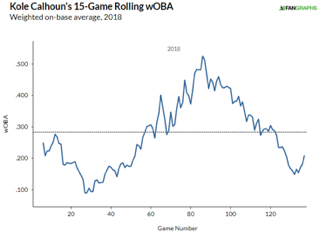
Hot streaks happen for any player, but what really looks weird for Calhoun is when you include his groundball trends during last season on that same chart:
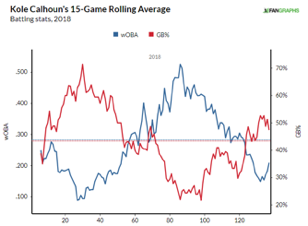
It was almost like he was either hurt, or he was trying to adjust his swing to take more advantage of the changes to the home park last year. Turns out, it was a little of both. Early on, he had a strained oblique that put him on the disabled list, and his hot streak began when he returned from that around Fathers' Day.
Calhoun and hitting coach Eric Hinske talked about some of the swing changes in this article in early August 2018:
Calhoun spent the winter trying to change his swing. Although Calhoun said it was simply to find more consistency, Hinske said he was also trying to join the launch angle revolution.
"He was trying to hit the bottom half of the baseball and hit the ball in the air and drive the ball out of the yard," Hinske said. "It turned into an uphill swing on him and he couldn't find his way out."
Essentially, Hinske said, Calhoun was trying to get under the ball with an uppercut swing, but he was doing it from such an upright stance that it required him to bring his head and hands down and then back up. All that motion, which obviously also included his eyes moving, made it difficult to track the baseball and square it up.
Hinske also said Calhoun's back hip was locked in place by his upright stance. Power comes from the legs turning the hips and then pulling the barrel through the zone.
Calhoun's problem was his hands were pulling the barrel out front before his hips could catch up, Hinske said. That resulted in weak contact and pulled ground balls.
Calhoun met with Jeremy Reed and Shawn Wooten, the Angels' Arizona-based minor-league hitting coordinators. They showed him video and helped him understand where his swing had gotten lost.
Reed and Wooten helped Calhoun develop a new stance, which was actually just a snapshot of a position he'd been trying to achieve all along. Instead of starting off upright and crouching slightly as the pitch approached, he began in the crouch. He eliminated some of the bat-wagging as he waited for the pitch.
That story was all fine and good for July and August, but September saw him return to the struggles that he had earlier in the year. If we look over his three-year trend, the groundball rate has continued to hang around despite Calhoun's efforts to eradicate it and get more loft on the ball.
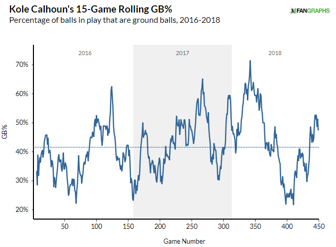
If Calhoun can get back into where he was over this past summer, which is not far from where he was when myself and others really liked him before last season, Calhoun could net quite a bit of profit. He is projected to once again hit leadoff in front of the best player in baseball, so the potential is once again enticing.
Matt Harvey is a top-100 pitcher. He is currently 144th on the pitcher depth chart just behind the likes of Michael Pineda, Anthony DeSclafani, and Brad Peacock, and just ahead of Aaron Sanchez, Chase Anderson, and Jake Odorizzi.
I just made you read more words than you likely wanted to read about why I am once again predicting a big year for Calhoun, so I will save you the time and simply link you to an article I wrote earlier this winter about why I think there is hidden value in Matt Harvey this year and his path forward to being a successful pitcher in 2019. He has not yet pitched in camp due to a strained glute muscle suffered during agility drills back on February 14th, but is expected to pitch in the coming days.
Oakland A's
Jurickson Profar is not a top-25 shortstop. He is currently 15th off the board, and has an ADP of 125. He has gone as high as 90th overall and as low as 165th overall. I have some concerns.
Profar's results at the plate outpaced his expected contact by 20 points, but there was a 60-point gap in his actual slugging percentage against his expected slugging percentage. He does not hit the ball very hard, and his slugging percentage success comes more from liners falling in for extra base hits than it does deep drives. His StatCast peers by launch angle and exit velocity have him grouped with the likes of Addison Russell, Denard Span and Odubel Herrera. He is also moving from the best run environment for park factors in 2018 to the third-worst in 2018 moving from Texas to Oakland. By home runs alone, Texas was the third-best stadium by home run park factors, while Oakland was the third-worst.
Profar is going to hit leadoff for the team as his plate discipline skills are a good fit for the role, unless the club wants to give Robbie Grossman and his walk rate time there (don't) or Chad Pinder time there (yes please). Then again, Ramon Laureano could also end up there. If Profar struggles out of the gate, he goes from the top of the lineup down to the bottom of it as the run production part of this lineup is rather stable. Simply put, I've been fading Profar in every draft I have done this offseason at his current price because I am scared the change in run environment is going to impact him rather negatively.
Marco Estrada is a top-100 starting pitcher. I did this with Mike Fiers last year, and I'm going to pin the tail on this donkey this year. Estrada desperately needed to get out of the AL East. His approach was simply too risky for the smallparks of the division, and he was punished at an abnormally high level last year. He is an extreme flyball pitcher, who annually has HR/FB ratios in the double-digits save 2015, when he was just under nine percent.
Rogers Centre had the eighth-worst park factor for home runs last year, and the AL East had three parks – Rogers, Yankee, and Camden – in the top 10. Oakland Coliseum had the third-lowest park factor for home runs last season, while the AL West has just one park in the top ten (Texas) and three parks below the league average (Seattle, Kansas City, Oakland).
Estrada's actual wOBA of .360 was 31 points higher than his xwOBA of .329. Had his actual wOBA been .329, he would have been in line with Joey Lucchesi, Michael Fulmer, Mike Leake and Chris Archer last year. His expected batting average was also 31 points lower than his real one, while the expected slugging was 70 points below the actual. The change in run environment should greatly benefit Estrada so that he is once again a usable pitcher in deeper leagues. He still has the same amount of swing and miss in his game, and his overall plate discipline numbers have remained rather constant over the past few years. This simply comes down to getting into a more spacious park, with a division that has better run environments, and keeping him on your bench when he has to pitch in the state of Texas.
Seattle Mariners
Jay Bruce is a top-50 outfielder. He is currently going 71st in Draft Champions leagues with an ADP of 276, 77 spots behind the 50th outfielder (Corey Dickerson). After four consecutive seasons of increases in both his home run and RBI totals, he had a career-worst 2018 limited by injuries. The upside was that he posted a career-high walk rate, and the second-lowest strikeout rate of his career, but the offensive production was below average due to the lack of run production and the poor batting average.
StatCast says his contact should have led to a batting average 26 points better than his .223 final number, while his actual slugging came in 68 points below his expected slugging percentage. Mind you, this is contact he put up with dealing with injuries last season. He is expected to share the 1B/DH rotation with Edwin Encarnacion, but should be in there for all matchups against right-handed pitchers while hopefully hiding when a lefty comes in.
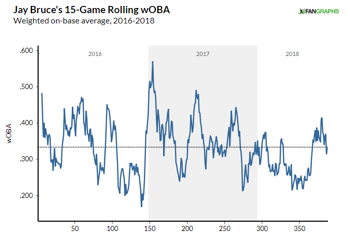
There is a lot of time above the league-average line there than not the last three years, but the considerable time below it in the middle part of last year has certainly dropped Bruce's value. If you're looking for a guy outside of the top 250 that could bring 25-plus homers, he should be one of the guys at the top of your list. I'm just about into the 18th round of two separate leagues right now, and Bruce is still available in both. I have the final pick of the 17th round and the first of the 18th, and I'm taking Franchy Cordero at pick 270 and Bruce with pick 271.
Erik Swanson earns $5 in AL-Only format. First off, I had to type his last name twice because I kept putting Hanson. Yes, I am dating myself. The Seattle rotation leaves us wanting more than the potential of Yusei Kikuchi, the boring Mike Leake, the fragile Marco Gonzales, the resurgent Wade LeBlanc and the shadow of what was once Felix Hernandez. King Felix is making $27.9M this year, so come hell or high water, he will pitch. Leake makes $16M, so he too will pitch, and the fact he is due $31M over the next two seasons means he is likely going to stay in Seattle to do so unless the team trades him for lesser prospects so the other team takes on salary. LeBlanc has affordable options years in his deal, so the club can be patient with him, while Gonzales was just signed to a very team friendly two-year extension.
For Hanson to pitch and earn something, someone has to get out of the way. It is not inconceivable one of them is moved to the pen or some kind of trade is not worked out as Seattle fades from contention this year. Heck, even Swanson could come up as a long reliever to help the pen. The most likely possibility is one of them spends time on the disabled list allowing Hanson (and Justus Sheffield) to come up and pitch. Hanson had an excellent 22 percent K-BB% in Triple-A last season striking out 27 percent of the hitters he faced while holding them to a .229 average. That came on the heels of a dominating stretch in Double-A where he struck out 35 percent of the hitters he faced and held them to a .155 average. Here is some nicely angled video of him pitching in High-A in 2017.
Swanson has now been parts of trades for both Carlos Beltran and James Paxton in his career, before ever throwing a major league pitch. The high punchout rate and low walk rate is an appealing skillset for a club whose starting rotation lacks both.
Texas Rangers
Delino DeShields Jr. steals 30 bases. To borrow from Bill Simmons and Matthew Berry, this is my fantasy kryptonite. I see this guy and I just cannot resist putting him on my roster no matter how terrible he is with a bat. He accepts his walks, but he strikes out quite a bit for someone with very little power, but that speed is tough to ignore!
By Sprint Speed, DeShields is seventh in the league at 30.0. The only players with faster sprint speed scores in 2018 were Byron Buxton (30.5), Roman Quinn (30.2), Magneuris Sierra (30.2), Adam Engel (30.1), Billy Hamilton (30.1), and Trea Turner (30.1). DeShields can fly, and he was successful in 20 of his 24 attempts last season over 393 plate appearances. He is currently slated to hit 9th in the lineup and play center field with Nomar Mazara and Joey Gallo starting on each side of him and Willie Calhoun waiting in the wings if we are to believe this noise about Gallo playing center field.
The positive part of DeShields is last year was the third year in a row he has increased his walk rate while reducing his strikeout rate. These are all positive signs, but with all of his speed, he still owns a career .244 average over 1528 major league plate appearances because he makes such bad contact. He has to rely on his legs to get most of his damage as his contact is soft, like 308th out of 313th for all qualified batters in 2018 soft.
New manager Chris Woodward may be more aggressive with the running game than his predecessor was, as long as DeShields can avoid long slumps at the plate
Lance Lynn is a top-100 starting pitcher. He is currently sitting 172nd on lists, with an ADP of 427. Lynn had a tale of two seasons – a terrible stint in Minnesota and a quietly awesome one with New York. Lynn had a 5.10 ERA and a 1.63 WHIP with a 8 percent K-BB% with Minnesota, but then went to the Yankees and had a 2.17 ERA, a 1.33 WHIP, and a strong 20 percent K-BB%. Lynn got hurt by a .364 BABIP with the Yankees that led to extra hits, but StatCast tells us that Lynn's expected batting average was 25 points better than his actual .265 opponents' batting average. Simply put, he got better as the season went on, which is to be expected from guys continuing to make their return from Tommy John surgery as pitch command is always the last thing to return:
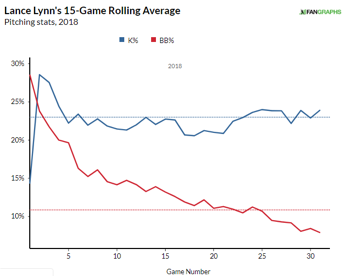
Pitching in Texas will not be fun given its park factors last season, but at least he has three other parks that are in the bottom half of park factors to help offset what he has to do pitching games in the state of Texas. Lynn is free money where he sits in drafts, so a reserve round pick for rotation depth will return a decent profit for you.










